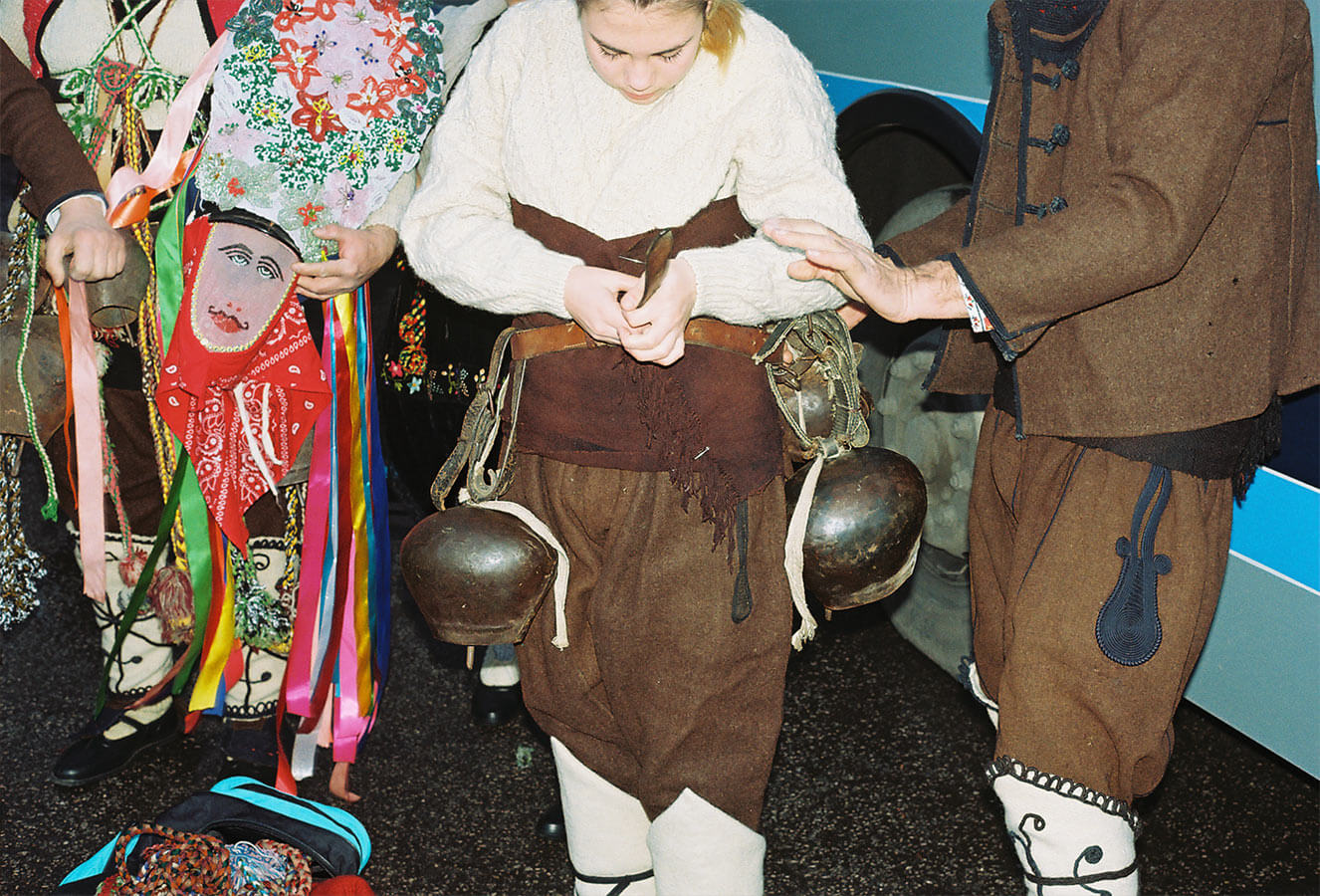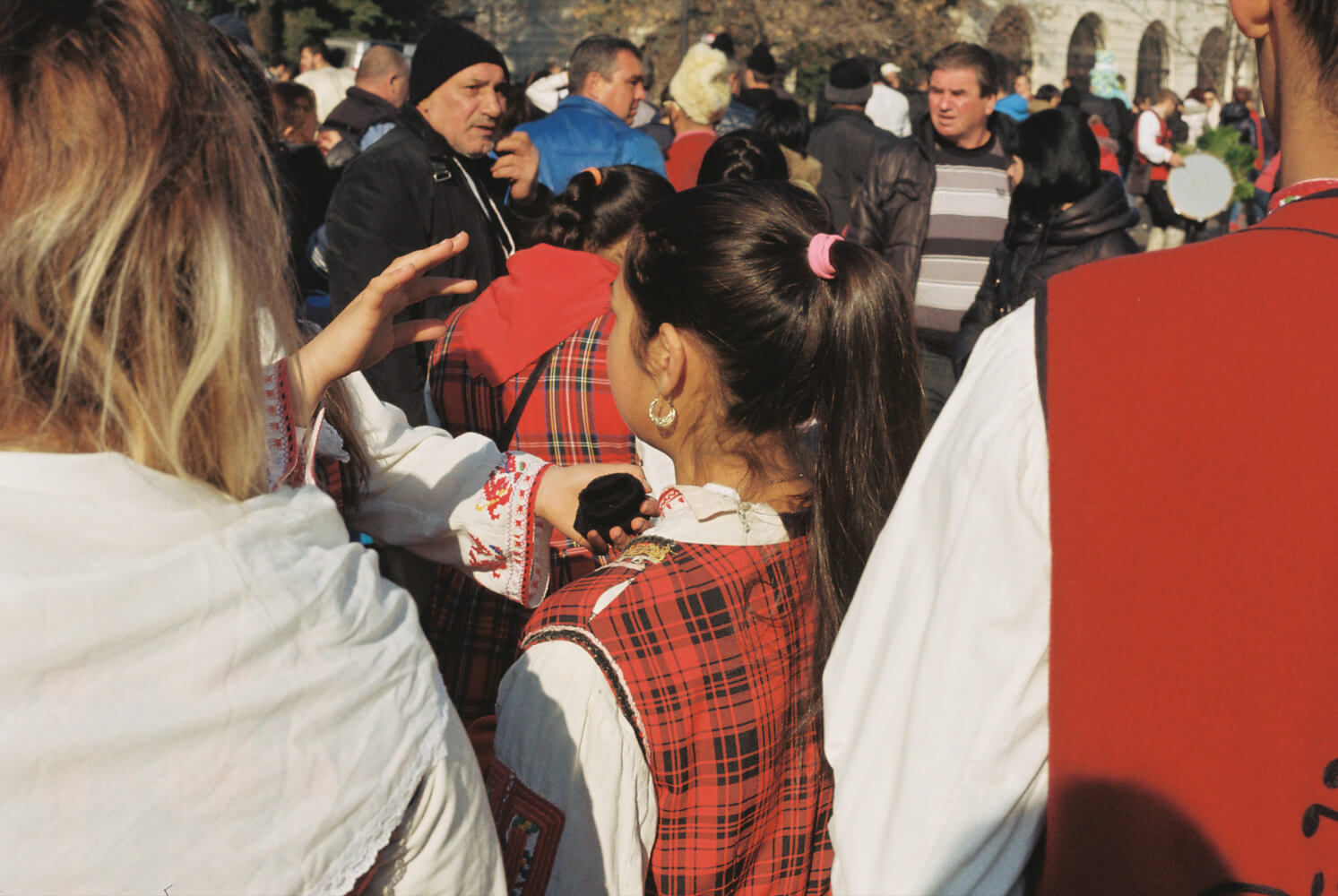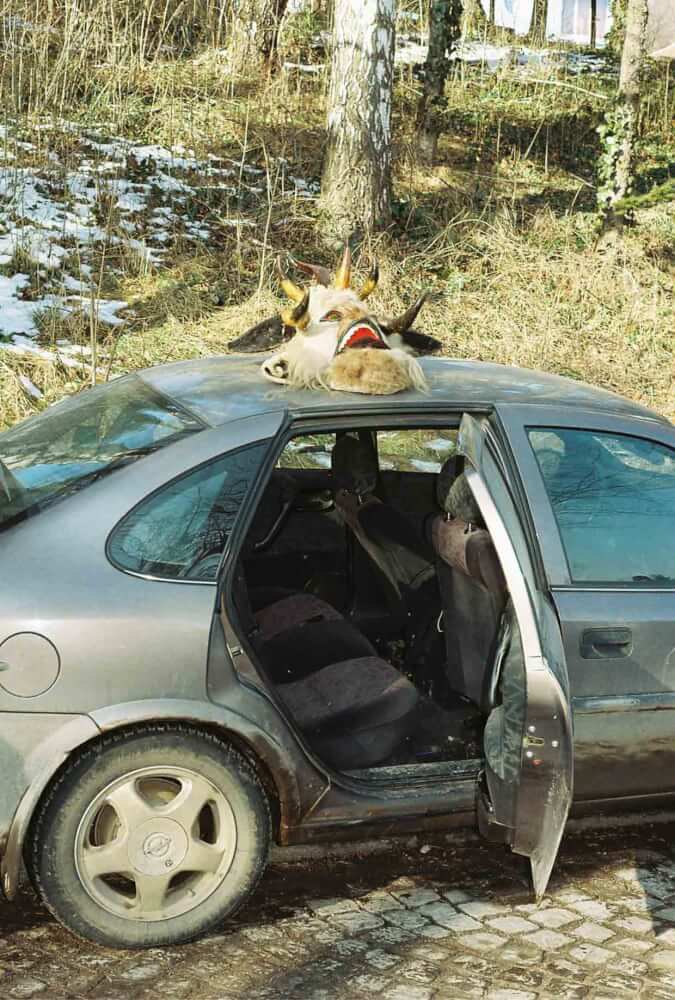

As dawn breaks, just after New Year, the Kukeri begin their exorcism all across Bulgaria — a tradition as old as daybreak ensues the villagers until lent. The Kukeri wrap their faces in an array of carved wood, fur and bells — crass imitations of beasts and birds drape over their once-human features. They dance through the villages, larger than life in arcane rituals intended to dispel evil spirits and bring harmony and bountiful harvests. They enter family homes lured by their own bestial trance to perform blessings and bring good will. Something between the human and the savage vandal, they morph together between cracks of dawn light.
It's an age-old tradition of humans to disguise and mask themselves when dealing with the Other — we generally see this other as a form of evil spirit but potentially a living enemy as well. Symbolically, the mask-wearer alters their narrative or identity to ward off the Other. This act of disguise enables inter/cross-generational compositions of the same narrative via a masked face, which is why the Kukeri tradition still lives on today.
This sentiment of cultural disguise to banish evil spirits may seem outdated at first but it is, in fact, still present in our newly founded technological paradigm, and the techniques to exorcise these spirits are not entirely new either. Today, we can see the border between technology (formerly known as nature) and culture to be a fluid one. Perhaps we can even say it’s a much smoother transition now, as we believe we can operate nature, rather than submitting to its whims. It’s commonplace to describe technology as an edifying practice nowadays, made up of intellectual manifestos and social histories — mapped by the method, media and image — all of which run over our own unique screened worlds, which sit inches away from our fingertips.


To become anonymous to evil is the only way one can survive, it seems.
In 1600 BC, the Kukeri attire was the default mask for telling the evils of the world to stay at bay. In the last few years it's more likely to be the Guy Fawkes mask — worn by various protestors but heavily affiliated with the hacking group Anonymous — or the multi-coloured knitted balaclavas of the political pop group Pussy Riot. Oscar Wilde once said, “Give a man a mask and he will tell you the truth.” These contemporary masks, the balaclava, the signature depiction of Fawkes are in fact the social truth-telling hieroglyphics of our time. This duality — masks against terror, has even bled into popular culture, which has then looped back into political affect.
Take the film V for Vendetta as an example: set in the year 2020, following a world war, London is under a police state occupied by a fascist government. The protagonist V in an elaborate special effect plot reactivates the story of Guy Fawkes, who originally tried to burn down the parliament building on November 5, 1605. V uses the old narrative to aid his freedom fighting escapades, and to get himself called a terrorist on national television. V wears the mask that is now synonymous with the Anonymous movement — chiselled, grinning and somewhat dapper. In essence, we see one cultural icon becoming the other, and as is stated in the opening lines of the film, this is a protocol of survival: “We are told to remember the idea, not the man, because the man can be killed.”
The gesture of mask wearing has been built in a world where to speak the truth, both on and offline, you must be covert — this has become an increasing necessity as the evils of which you are now fighting have a much more advanced methods of revealing the identities of those who become societal agitators to their cause. The general aim of these masked insurrectionaries is to ward off harmful ideas and warn the global villagers of any foreboding fascist gesture in both an on and offline world. Generally we see this from a leftist perspective — Anonymous, Pussy Riot, the Black Bloc, Antifa all wear masks, whereas the alt-right protestors including the English Defence League, Golden Dawn, Pegida, The Daily Stormer tend to take a more masked off approach when speaking of their enemies in the streets or forums. We can only assume this is because they feel they will not be targeted by the elite power structures in play. Saying that, religious right extremist like Hamas and ISIS also mask themselves — leading to many online memes asking who wears it better? Let’s say in this case the Left wore it better and the remainder of the essay will concern itself with the binary act of wearing a mask to defeat an evil larger than oneself from a leftist revolutionary perspective.

This idea of wearing a mask for survival seems to be imminent in both past and present traditions of mask wearing. As does the act of bravery and courage that accompanies it. To become anonymous to evil is the only way one can survive, it seems. This moment could be declared as self-sculpturisation or self-monumentalisation. Boris Groys says this procedure is one in which the body undergoes strategies and designs. This self-monumentalisation creates the fullest possible moment of visibility. Disregarding the user's own figure, but turning the body into a communal figure inside a public space — the user has to become public, to represent the collective and maintain invisibility for survival. But this idea of disguise is not so simple; it not only allows the wearer to become anonymous but also allows them to slip into another role, identity or character — this can be both beneficial and/or a tyrannical mobocracy can be formed
Hence in the case of Black Bloc, the ability to become anonymous also enables the wearer to become destructive using the modus of direct action. This is enabled only when the wearer is dressed all in black and around a significant number of other Black Bloc protestors — this is called The Human Swarm. The same technique is used via Anonymous online.
So, in essence, this act of becoming conceptually human allows the best landscape for defeating evil. In the case of our new natural technological landscape, we see the Anonymous mask as the conceptual human, because it takes the position of a saint defeating the evil state nodes and apparatus through pseudonymous Internet vigilantism, for the people by the people. This act of masking allows the individual to become the ultimate humanist vessel, this would not be possible if the individual was unmasked as they would easily become Other to some people, depending on their skin colour, age, gender, or any other attribute that has an other-ing property. To disguise the human is to become an all encompassing human.

We live in a real-time b-movie horror adaptation of the myth of Narcissus.
Roger Caillots and Jacques Lacan often argue that the human creates image production primarily to serve as a goal of self-protection. By producing an image, we create a trap that functions to lure the evil eye through a series of distractions (Lacan argues the evil eye is always the eye of the social Other). This concept would suggest that the gaze of the Other, the enemy let's say, can be caught by the manufactured image of the antagonist, enabling one to escape without notice. We can apply this idea to most successful political actions today — revolt masked and you have a micro chance of getting away. Show your face in today's world and it takes a second for the tech companies to run your face through recognition units, pulling up your name, email, telephone number, address, family, friends and viewing your last moments via geo-tagging technology. But this is where history has changed the enemy and now builds masks of its victims before they go into battle.
These non-collaborative cabalistic portraits, where the subject is neither consensual nor aware, could be declared the real evil of mask making today. Ironically, they frame these compositions in a mask-off world. What is so genius about these newly formed technological evil spirits, (Apple, Microsoft, Google, Amazon and Facebook) is that they seduce you. The user offers them their very own death mask, inadvertently, and through these systems they hack the human form, creating inactive voodoo dolls of each potential opponent. They are harvesting bodies on the public square, cataloguing limbs in broad daylight and the only way to ward off these evil spirits is to remain unseen.



Vernacular postmodernism has dealt with the ‘crisis of symbolic efficiency’ through meta-fictional anxieties about the function of the author or mask-wearer. Take the example of ‘who wore it better?’ — the Black Bloc or the ISIS troops. This is only answerable in relation to the viewers reality-belief system. Which is commonly created from their individual political understanding, rooted in their proverbial society. There is in fact no right or wrong answer. Hence postmodernism’s supposed gestures of demystification do not reveal the sophistication of this narrative. Saying that to banish these evil spirits is not as easy as it once was with the Kukeri, the act of a complete exorcism or self-purification is almost impossible today, because the spirits of evil are just as much human as you or I. The act can only succeed if we ultimately purify oneself from oneself. The contemporary human is both the demon and its mask-wearing counterpart — we live in a real-time b-movie horror adaptation of the myth of Narcissus. The human made the Kukeri, but it also made the algorithm. Spirits are abstract and ultimately fabricated folklore, but that's not to say they can be slain as easily by the civilised hominid of today, nor does it mean we want to live in a world without any Other — be it state, spirit or algorithm.

Text: Penny Rafferty
Photography: Katarina Šoškić


As dawn breaks, just after New Year, the Kukeri begin their exorcism all across Bulgaria — a tradition as old as daybreak ensues the villagers until lent. The Kukeri wrap their faces in an array of carved wood, fur and bells — crass imitations of beasts and birds drape over their once-human features. They dance through the villages, larger than life in arcane rituals intended to dispel evil spirits and bring harmony and bountiful harvests. They enter family homes lured by their own bestial trance to perform blessings and bring good will. Something between the human and the savage vandal, they morph together between cracks of dawn light.
It's an age-old tradition of humans to disguise and mask themselves when dealing with the Other — we generally see this other as a form of evil spirit but potentially a living enemy as well. Symbolically, the mask-wearer alters their narrative or identity to ward off the Other. This act of disguise enables inter/cross-generational compositions of the same narrative via a masked face, which is why the Kukeri tradition still lives on today.
This sentiment of cultural disguise to banish evil spirits may seem outdated at first but it is, in fact, still present in our newly founded technological paradigm, and the techniques to exorcise these spirits are not entirely new either. Today, we can see the border between technology (formerly known as nature) and culture to be a fluid one. Perhaps we can even say it’s a much smoother transition now, as we believe we can operate nature, rather than submitting to its whims. It’s commonplace to describe technology as an edifying practice nowadays, made up of intellectual manifestos and social histories — mapped by the method, media and image — all of which run over our own unique screened worlds, which sit inches away from our fingertips.


To become anonymous to evil is the only way one can survive, it seems.
In 1600 BC, the Kukeri attire was the default mask for telling the evils of the world to stay at bay. In the last few years it's more likely to be the Guy Fawkes mask — worn by various protestors but heavily affiliated with the hacking group Anonymous — or the multi-coloured knitted balaclavas of the political pop group Pussy Riot. Oscar Wilde once said, “Give a man a mask and he will tell you the truth.” These contemporary masks, the balaclava, the signature depiction of Fawkes are in fact the social truth-telling hieroglyphics of our time. This duality — masks against terror, has even bled into popular culture, which has then looped back into political affect.
Take the film V for Vendetta as an example: set in the year 2020, following a world war, London is under a police state occupied by a fascist government. The protagonist V in an elaborate special effect plot reactivates the story of Guy Fawkes, who originally tried to burn down the parliament building on November 5, 1605. V uses the old narrative to aid his freedom fighting escapades, and to get himself called a terrorist on national television. V wears the mask that is now synonymous with the Anonymous movement — chiselled, grinning and somewhat dapper. In essence, we see one cultural icon becoming the other, and as is stated in the opening lines of the film, this is a protocol of survival: “We are told to remember the idea, not the man, because the man can be killed.”
The gesture of mask wearing has been built in a world where to speak the truth, both on and offline, you must be covert — this has become an increasing necessity as the evils of which you are now fighting have a much more advanced methods of revealing the identities of those who become societal agitators to their cause. The general aim of these masked insurrectionaries is to ward off harmful ideas and warn the global villagers of any foreboding fascist gesture in both an on and offline world. Generally we see this from a leftist perspective — Anonymous, Pussy Riot, the Black Bloc, Antifa all wear masks, whereas the alt-right protestors including the English Defence League, Golden Dawn, Pegida, The Daily Stormer tend to take a more masked off approach when speaking of their enemies in the streets or forums. We can only assume this is because they feel they will not be targeted by the elite power structures in play. Saying that, religious right extremist like Hamas and ISIS also mask themselves — leading to many online memes asking who wears it better? Let’s say in this case the Left wore it better and the remainder of the essay will concern itself with the binary act of wearing a mask to defeat an evil larger than oneself from a leftist revolutionary perspective.

This idea of wearing a mask for survival seems to be imminent in both past and present traditions of mask wearing. As does the act of bravery and courage that accompanies it. To become anonymous to evil is the only way one can survive, it seems. This moment could be declared as self-sculpturisation or self-monumentalisation. Boris Groys says this procedure is one in which the body undergoes strategies and designs. This self-monumentalisation creates the fullest possible moment of visibility. Disregarding the user's own figure, but turning the body into a communal figure inside a public space — the user has to become public, to represent the collective and maintain invisibility for survival. But this idea of disguise is not so simple; it not only allows the wearer to become anonymous but also allows them to slip into another role, identity or character — this can be both beneficial and/or a tyrannical mobocracy can be formed
Hence in the case of Black Bloc, the ability to become anonymous also enables the wearer to become destructive using the modus of direct action. This is enabled only when the wearer is dressed all in black and around a significant number of other Black Bloc protestors — this is called The Human Swarm. The same technique is used via Anonymous online.
So, in essence, this act of becoming conceptually human allows the best landscape for defeating evil. In the case of our new natural technological landscape, we see the Anonymous mask as the conceptual human, because it takes the position of a saint defeating the evil state nodes and apparatus through pseudonymous Internet vigilantism, for the people by the people. This act of masking allows the individual to become the ultimate humanist vessel, this would not be possible if the individual was unmasked as they would easily become Other to some people, depending on their skin colour, age, gender, or any other attribute that has an other-ing property. To disguise the human is to become an all encompassing human.

We live in a real-time b-movie horror adaptation of the myth of Narcissus.
Roger Caillots and Jacques Lacan often argue that the human creates image production primarily to serve as a goal of self-protection. By producing an image, we create a trap that functions to lure the evil eye through a series of distractions (Lacan argues the evil eye is always the eye of the social Other). This concept would suggest that the gaze of the Other, the enemy let's say, can be caught by the manufactured image of the antagonist, enabling one to escape without notice. We can apply this idea to most successful political actions today — revolt masked and you have a micro chance of getting away. Show your face in today's world and it takes a second for the tech companies to run your face through recognition units, pulling up your name, email, telephone number, address, family, friends and viewing your last moments via geo-tagging technology. But this is where history has changed the enemy and now builds masks of its victims before they go into battle.
These non-collaborative cabalistic portraits, where the subject is neither consensual nor aware, could be declared the real evil of mask making today. Ironically, they frame these compositions in a mask-off world. What is so genius about these newly formed technological evil spirits, (Apple, Microsoft, Google, Amazon and Facebook) is that they seduce you. The user offers them their very own death mask, inadvertently, and through these systems they hack the human form, creating inactive voodoo dolls of each potential opponent. They are harvesting bodies on the public square, cataloguing limbs in broad daylight and the only way to ward off these evil spirits is to remain unseen.



Vernacular postmodernism has dealt with the ‘crisis of symbolic efficiency’ through meta-fictional anxieties about the function of the author or mask-wearer. Take the example of ‘who wore it better?’ — the Black Bloc or the ISIS troops. This is only answerable in relation to the viewers reality-belief system. Which is commonly created from their individual political understanding, rooted in their proverbial society. There is in fact no right or wrong answer. Hence postmodernism’s supposed gestures of demystification do not reveal the sophistication of this narrative. Saying that to banish these evil spirits is not as easy as it once was with the Kukeri, the act of a complete exorcism or self-purification is almost impossible today, because the spirits of evil are just as much human as you or I. The act can only succeed if we ultimately purify oneself from oneself. The contemporary human is both the demon and its mask-wearing counterpart — we live in a real-time b-movie horror adaptation of the myth of Narcissus. The human made the Kukeri, but it also made the algorithm. Spirits are abstract and ultimately fabricated folklore, but that's not to say they can be slain as easily by the civilised hominid of today, nor does it mean we want to live in a world without any Other — be it state, spirit or algorithm.

Text: Penny Rafferty
Photography: Katarina Šoškić

